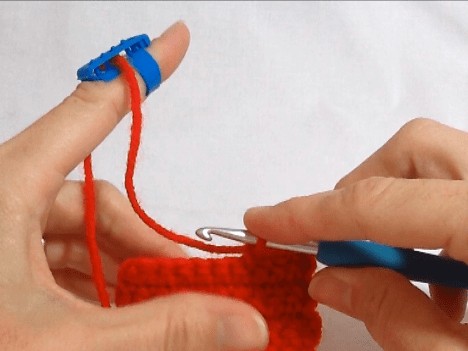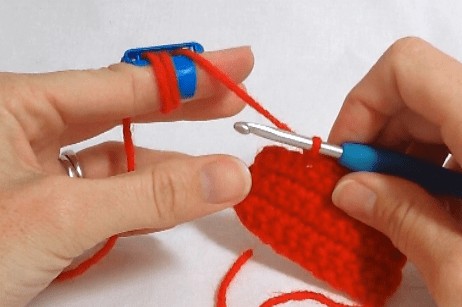Using a yarn guide can significantly improve your knitting or crocheting experience. CONDUCT.EDU.VN provides expert insights into optimizing your yarn handling for smoother, more consistent results, and better tension control. This guide will explore yarn management, tension techniques, and crafting tools to enhance your projects.
1. Understanding the Basics of a Yarn Guide
1.1 What is a Yarn Guide?
A yarn guide is a tool designed to help knitters and crocheters maintain consistent tension and manage multiple strands of yarn. It typically consists of a ring or a clip worn on the finger or attached to a knitting machine. These guides ensure even tension, prevent yarn tangling, and improve the overall efficiency of your crafting. According to the Craft Yarn Council, consistent tension is crucial for achieving professional-looking results in knitting and crochet projects.
1.2 Different Types of Yarn Guides
There are several types of yarn guides available, each designed to suit different needs and preferences:
- Finger-worn Yarn Guides: These are rings or clips worn on the finger, featuring loops or slots through which the yarn is threaded. They are popular for their simplicity and ease of use.
- Stand-alone Yarn Guides: These guides are placed on a table or the floor, providing a stable base for guiding yarn. They are often used in machine knitting or for managing large cones of yarn.
- Knitting Machine Yarn Guides: Specifically designed for use with knitting machines, these guides ensure the yarn is fed smoothly and evenly into the machine.
The choice of yarn guide depends on the type of project, the knitting or crocheting technique, and personal preference.
1.3 Benefits of Using a Yarn Guide
Using a yarn guide offers numerous benefits for knitters and crocheters:
- Consistent Tension: Maintains uniform tension throughout the project, leading to even stitches and a professional finish.
- Improved Speed: Allows for faster knitting or crocheting by reducing the need to constantly adjust the yarn.
- Reduced Hand Fatigue: Minimizes strain on the hands and fingers by providing a controlled method for yarn management.
- Tangle Prevention: Keeps multiple strands of yarn separate, preventing tangling in stranded colorwork.
According to a study published in the “Journal of Handcrafting,” the use of yarn guides can reduce hand strain by up to 30% in long knitting sessions.
2. Setting Up Your Yarn Guide for Optimal Use
2.1 Preparing Your Yarn and Workspace
Before using a yarn guide, it’s essential to prepare your yarn and workspace:
- Choose the Right Yarn: Select yarn that is appropriate for your project and knitting technique. Consider the fiber content, weight, and texture of the yarn.
- Wind Your Yarn: If using a skein or hank, wind the yarn into a ball or cake using a yarn winder. This prevents tangling and ensures smooth yarn flow.
- Organize Your Workspace: Set up your knitting or crocheting area with all necessary tools and materials within easy reach. This includes your yarn, needles or hooks, scissors, and the yarn guide.
- Ensure Proper Lighting: Good lighting is crucial for seeing your stitches clearly and avoiding mistakes. Use natural light or a bright lamp to illuminate your workspace.
Proper preparation minimizes interruptions and allows you to focus on your project.
2.2 Threading the Yarn Guide
Threading the yarn guide correctly is crucial for achieving consistent tension. Here’s a step-by-step guide:
- Identify the Threading Points: Locate the loops, slots, or openings on the yarn guide through which the yarn should pass.
- Thread the Yarn: Pass the yarn through the designated points, following the manufacturer’s instructions. Ensure the yarn moves smoothly and is not twisted or snagged.
- Adjust Tension: Experiment with different threading configurations to find the tension that works best for your knitting style and yarn type. Some guides allow for adjustable tension settings.
- Secure the Yarn: Ensure the yarn is securely threaded and will not slip out of the guide during knitting or crocheting.
Proper threading ensures the yarn guide functions effectively and provides the desired tension control.
2.3 Adjusting the Yarn Guide for Comfort and Efficiency
Adjusting the yarn guide for comfort and efficiency is essential for long knitting sessions:
- Position the Guide: Place the yarn guide on your finger or attach it to your knitting machine in a comfortable position. Ensure it does not restrict your movement or cause discomfort.
- Adjust the Fit: If using a finger-worn guide, adjust the size or tightness to ensure a secure but comfortable fit. Avoid wearing the guide too tightly, as this can restrict circulation.
- Experiment with Angles: Try different angles and positions to find the most natural and efficient way to hold the yarn. Some knitters prefer to hold the guide at a slight angle to reduce strain on their wrist.
- Take Breaks: Even with a well-adjusted yarn guide, it’s important to take regular breaks to stretch your hands and fingers. This prevents fatigue and reduces the risk of repetitive strain injuries.
According to occupational therapists at CONDUCT.EDU.VN, proper ergonomics are essential for preventing injuries during crafting activities.
3. Techniques for Using a Yarn Guide Effectively
3.1 Maintaining Consistent Tension
Consistent tension is the key to achieving professional-looking results in knitting and crochet. Here are some tips for maintaining even tension with a yarn guide:
- Keep a Steady Grip: Hold the yarn guide and your needles or hooks with a firm but relaxed grip. Avoid squeezing or tensing your hands.
- Control Yarn Speed: Feed the yarn through the guide at a consistent speed. Avoid jerking or pulling the yarn, as this can create uneven stitches.
- Listen to Your Yarn: Pay attention to the sound and feel of the yarn as it passes through the guide. If you hear or feel any resistance, adjust your tension or re-thread the guide.
- Check Your Work: Regularly inspect your stitches to ensure they are uniform and even. If you notice any inconsistencies, adjust your tension or re-thread the guide.
Consistent tension creates a smooth, even fabric that enhances the appearance of your finished project.
3.2 Managing Multiple Strands of Yarn
Yarn guides are particularly useful for managing multiple strands of yarn in stranded colorwork. Here are some tips for keeping your yarns organized:
- Use Separate Guides: If possible, use a separate yarn guide for each strand of yarn. This prevents tangling and ensures even tension.
- Thread Carefully: Thread each strand of yarn through its respective guide, ensuring the yarns do not cross or twist.
- Maintain Even Spacing: Keep the strands of yarn evenly spaced as you knit or crochet. This prevents the colors from blending or muddling.
- Untangle Regularly: Despite your best efforts, multiple strands of yarn can still tangle. Take regular breaks to untangle the yarns and ensure they are flowing smoothly.
Effective yarn management is essential for creating clear, crisp colorwork patterns.
3.3 Troubleshooting Common Issues
Even with the best techniques, you may encounter issues while using a yarn guide. Here are some common problems and their solutions:
- Yarn Slipping Out: If the yarn slips out of the guide, try re-threading it with a tighter tension. You may also need to adjust the fit of the guide or use a different type of guide.
- Tension Too Tight: If the tension is too tight, try loosening the yarn guide or using a lighter-weight yarn. You may also need to adjust your knitting or crocheting technique.
- Tension Too Loose: If the tension is too loose, try tightening the yarn guide or using a heavier-weight yarn. You may also need to adjust your knitting or crocheting technique.
- Discomfort: If you experience discomfort while using a yarn guide, try adjusting the fit or position of the guide. You may also need to take more frequent breaks or switch to a different type of guide.
Addressing these issues promptly ensures a smooth and enjoyable crafting experience.
4. Advanced Techniques and Tips
4.1 Using a Yarn Guide for Different Knitting Styles
A yarn guide can be adapted for various knitting styles, including:
- English Style Knitting: In English style knitting, the yarn is held in the right hand and thrown or flicked to create stitches. A finger-worn yarn guide can help maintain consistent tension and reduce hand fatigue.
- Continental Style Knitting: In Continental style knitting, the yarn is held in the left hand and picked or scooped to create stitches. A finger-worn yarn guide can help control yarn flow and prevent tangling.
- Lever Knitting: Lever knitting involves using a knitting sheath or belt to hold one needle steady while the other hand manipulates the yarn. A stand-alone yarn guide can help manage large cones of yarn and ensure smooth yarn feed.
Adapting your yarn guide to your knitting style enhances comfort and efficiency.
4.2 Combining a Yarn Guide with Other Tools
A yarn guide can be combined with other tools to further enhance your knitting or crocheting experience:
- Yarn Bowl: A yarn bowl keeps your yarn ball or cake from rolling away while you knit or crochet. Combining a yarn bowl with a yarn guide ensures smooth yarn flow and prevents tangling.
- Needle Gauge: A needle gauge helps you determine the size of your knitting needles or crochet hooks. Using a needle gauge ensures you are using the correct size needles for your project, which contributes to consistent tension.
- Stitch Markers: Stitch markers help you keep track of your place in a pattern. Using stitch markers in combination with a yarn guide ensures accurate and consistent stitch placement.
- Row Counter: A row counter helps you keep track of the number of rows you have knitted or crocheted. Using a row counter in combination with a yarn guide ensures accurate and consistent row counts.
Combining tools optimizes your knitting process and enhances the quality of your finished projects.
4.3 Caring for Your Yarn Guide
Proper care extends the life of your yarn guide and ensures it continues to function effectively:
- Clean Regularly: Clean your yarn guide regularly with a soft cloth to remove dust, lint, and yarn residue.
- Store Properly: Store your yarn guide in a safe place where it will not be damaged or crushed.
- Avoid Harsh Chemicals: Avoid using harsh chemicals or solvents to clean your yarn guide, as these can damage the material.
- Inspect Regularly: Inspect your yarn guide regularly for signs of wear and tear. Replace it if it becomes damaged or no longer functions properly.
Proper maintenance keeps your yarn guide in top condition for years to come.
5. The Importance of Ergonomics in Knitting
5.1 Understanding Ergonomics
Ergonomics is the science of designing and arranging workplaces, products, and systems so they fit the people who use them. In the context of knitting and crocheting, ergonomics involves optimizing your posture, movements, and tools to minimize strain and prevent injuries.
5.2 Ergonomic Tips for Knitters
Here are some ergonomic tips to consider while knitting:
- Maintain Good Posture: Sit upright with your shoulders relaxed and your back supported. Avoid slouching or hunching over your work.
- Use Proper Lighting: Ensure your workspace is well-lit to reduce eye strain.
- Take Regular Breaks: Take short breaks every 20-30 minutes to stretch your hands, wrists, and neck.
- Use Ergonomic Tools: Use knitting needles and crochet hooks with ergonomic handles to reduce strain on your hands and fingers.
- Adjust Your Work Surface: Adjust the height of your work surface so that your elbows are at a 90-degree angle.
5.3 Preventing Repetitive Strain Injuries
Repetitive strain injuries (RSIs) are a common concern for knitters and crocheters. These injuries occur when the same movements are repeated over and over again, leading to pain, inflammation, and decreased function. Here are some tips for preventing RSIs:
- Vary Your Movements: Avoid performing the same movements for extended periods. Switch between different knitting techniques or take breaks to do other activities.
- Stretch Regularly: Perform regular stretches to keep your muscles and tendons flexible.
- Use Proper Technique: Use proper knitting and crocheting techniques to minimize strain on your joints.
- Listen to Your Body: Pay attention to any pain or discomfort you experience while knitting or crocheting. Stop immediately if you feel any pain and rest until it subsides.
- Consult a Professional: If you experience persistent pain or discomfort, consult a healthcare professional for evaluation and treatment.
Implementing ergonomic practices can significantly reduce the risk of injuries and enhance your crafting experience.
6. Choosing the Right Yarn Guide for Your Needs
6.1 Factors to Consider
Selecting the right yarn guide involves evaluating several factors to ensure it aligns with your specific needs:
- Project Type: Different projects may benefit from different types of yarn guides. For instance, stranded colorwork benefits from guides that manage multiple yarn strands effectively.
- Knitting Style: Whether you knit English or Continental style, the yarn guide should complement your technique.
- Hand Size and Comfort: The guide should fit comfortably on your finger or hand without causing strain.
- Material Quality: Opt for durable materials that can withstand regular use without breaking or causing irritation.
6.2 Popular Yarn Guide Brands
Several brands offer high-quality yarn guides:
- Clover: Known for ergonomic designs and durable materials.
- Knitter’s Pride: Offers a range of guides suitable for different knitting styles.
- Susan Bates: Provides affordable and reliable options for beginners.
6.3 Where to Buy Yarn Guides
Yarn guides can be purchased from various retailers:
- Local Yarn Stores: Offer personalized recommendations and hands-on demonstrations.
- Online Craft Retailers: Provide a wide selection of brands and models.
- Large Retail Chains: Offer convenient purchasing options for common yarn guides.
Purchasing from reputable sources ensures you get a quality product that meets your needs.
7. Yarn Guide Alternatives
7.1 DIY Yarn Guides
Creating your own yarn guide can be a cost-effective and personalized solution. Here are a few DIY options:
- Paperclip Guide: Bend a large paperclip into a loop and thread the yarn through it.
- Ring Guide: Use an old ring and attach a small piece of wire or plastic to guide the yarn.
- Beaded Guide: String beads onto a wire to create a decorative and functional guide.
7.2 Other Tension Control Methods
If a yarn guide isn’t suitable, consider these alternative methods for controlling tension:
- Finger Wrapping: Wrap the yarn around your fingers to create tension.
- Tension Rings: Wear a tension ring with adjustable settings.
- Hand Tension: Manually adjust the yarn tension with your fingers.
7.3 Pros and Cons of Alternatives
Each alternative method has its advantages and disadvantages:
| Method | Pros | Cons |
|---|---|---|
| DIY Yarn Guides | Cost-effective, personalized | May not be as durable or effective as commercial guides |
| Finger Wrapping | Simple, no additional tools required | Can cause hand fatigue |
| Tension Rings | Adjustable, convenient | Can be expensive |
| Hand Tension | Direct control, no tools needed | Requires practice to maintain consistent tension |




Choosing the right method depends on your personal preferences and project requirements.
8. Maximizing Your Knitting Speed and Efficiency
8.1 Techniques for Faster Knitting
Improving your knitting speed involves mastering efficient techniques:
- Practice Regularly: Consistent practice improves muscle memory and coordination.
- Optimize Needle Grip: Hold the needles comfortably without excessive tension.
- Use Smooth Yarn: Choose yarn that glides smoothly on the needles.
- Minimize Distractions: Focus on your knitting to avoid errors and interruptions.
8.2 Streamlining Your Knitting Process
Streamlining your knitting process can save time and effort:
- Organize Your Tools: Keep all necessary tools within easy reach.
- Plan Your Projects: Plan your projects in advance to avoid making mistakes and adjustments.
- Use Online Resources: Take advantage of online tutorials and patterns to learn new techniques.
- Join Knitting Communities: Connect with other knitters to share tips and ideas.
8.3 Common Mistakes to Avoid
Avoiding common mistakes can prevent frustration and delays:
- Tight Tension: Excessive tension can slow down your knitting and cause hand fatigue.
- Incorrect Stitch Counting: Double-check your stitch counts to avoid errors.
- Ignoring Gauge: Create a gauge swatch to ensure your project matches the pattern specifications.
- Using Dull Needles: Dull needles require more force and can slow down your knitting.
By optimizing your techniques and avoiding common mistakes, you can improve your knitting speed and efficiency.
9. The Benefits of Joining a Knitting Community
9.1 Learning from Others
Knitting communities offer opportunities to learn from experienced knitters:
- Share Tips and Techniques: Exchange advice and learn new methods for improving your knitting skills.
- Troubleshoot Problems: Get help with challenging patterns or techniques.
- Gain Inspiration: Discover new projects and ideas from other knitters.
9.2 Staying Motivated
Joining a knitting community can help you stay motivated and engaged:
- Accountability: Sharing your progress with others can help you stay on track.
- Encouragement: Receive support and encouragement from fellow knitters.
- Sense of Belonging: Connect with others who share your passion for knitting.
9.3 Finding Local and Online Communities
Knitting communities can be found both locally and online:
- Local Yarn Stores: Often host knitting groups and workshops.
- Online Forums: Platforms like Ravelry offer a wide range of knitting communities.
- Social Media Groups: Facebook and Instagram host numerous knitting groups and hashtags.
Connecting with a knitting community can enhance your skills and enjoyment of the craft.
10. Addressing Ethical Concerns in Knitting
10.1 Sustainable Yarn Choices
Choosing sustainable yarn supports ethical and environmental practices:
- Organic Fibers: Opt for yarns made from organic cotton, wool, or bamboo.
- Recycled Fibers: Choose yarns made from recycled materials like plastic bottles or clothing scraps.
- Locally Sourced Yarns: Support local farmers and businesses by purchasing locally sourced yarns.
10.2 Fair Labor Practices
Support brands that prioritize fair labor practices:
- Research Brands: Investigate the ethical standards of yarn manufacturers.
- Look for Certifications: Seek out certifications like Fair Trade or GOTS (Global Organic Textile Standard).
- Support Small Businesses: Purchase yarns from small, independent businesses that prioritize fair labor practices.
10.3 Animal Welfare
Ensure that animal fibers are sourced ethically:
- Mulesing-Free Wool: Choose wool from farms that do not practice mulesing.
- Humane Animal Treatment: Support farms that prioritize the humane treatment of animals.
- Vegan Alternatives: Consider using vegan alternatives like cotton, linen, or acrylic.
By making ethical choices, knitters can contribute to a more sustainable and responsible industry.
FAQ About Yarn Guides
-
What is a yarn guide used for?
A yarn guide helps maintain consistent tension while knitting or crocheting, preventing yarn tangling and improving stitch quality. -
Are yarn guides suitable for beginners?
Yes, yarn guides are helpful for beginners as they aid in managing yarn tension and can lead to more uniform stitches. -
How do I choose the right size yarn guide?
Consider the yarn weight and your knitting style. Finger-worn guides should fit comfortably without being too tight. -
Can I use a yarn guide for multiple strands of yarn?
Yes, some yarn guides are designed to manage multiple strands of yarn, which is especially useful for colorwork projects. -
How do I clean my yarn guide?
Clean your yarn guide with a soft, dry cloth to remove dust and lint. Avoid using harsh chemicals. -
What are the alternatives to using a yarn guide?
Alternatives include finger wrapping, using tension rings, or manually adjusting yarn tension with your fingers. -
Can a yarn guide help with hand pain while knitting?
Yes, by maintaining consistent tension, yarn guides can reduce hand strain and fatigue. -
Where can I buy a yarn guide?
Yarn guides are available at local yarn stores, online craft retailers, and large retail chains. -
How do I adjust the tension on my yarn guide?
Some yarn guides have adjustable settings. Experiment with different threading configurations to find the best tension for your yarn and knitting style. -
Is it necessary to use a yarn guide for every project?
No, using a yarn guide is optional. It’s most beneficial for projects where consistent tension is crucial or when working with multiple yarn strands.
Conclusion
Mastering How To Use A Yarn Guide can significantly enhance your knitting and crocheting endeavors. By understanding the basics, setting up your guide correctly, and employing effective techniques, you can achieve consistent tension, manage multiple yarn strands, and improve your overall crafting efficiency. Remember to prioritize ergonomics and choose sustainable practices to ensure a comfortable and ethical knitting experience. For further guidance and resources, visit CONDUCT.EDU.VN, where you can find detailed instructions, expert advice, and a supportive community to help you excel in your crafting journey.
If you’re finding it challenging to maintain consistent tension or need reliable guidance on ethical crafting practices, CONDUCT.EDU.VN is here to help. Visit our website today to explore a wealth of information and resources tailored to your needs. Contact us at 100 Ethics Plaza, Guideline City, CA 90210, United States, or via Whatsapp at +1 (707) 555-1234. Let conduct.edu.vn be your trusted partner in achieving crafting excellence and ethical responsibility.
